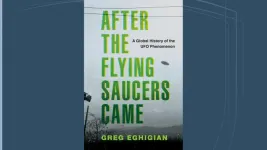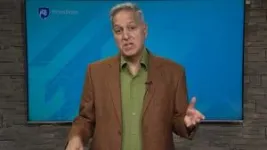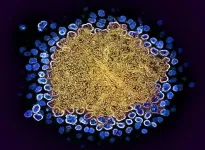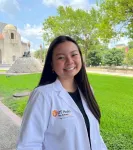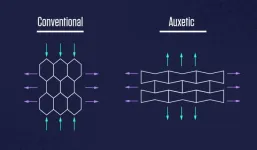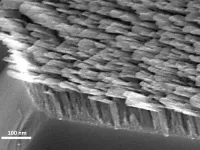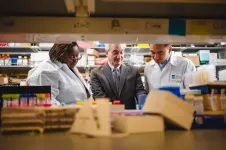(Press-News.org) UNIVERSITY PARK, Pa. — The end of the Second World War ushered in a new age, one dominated by novel technologies, the Cold War, the threat of nuclear destruction — and the first reported UFO sightings.
Humans have witnessed strange aerial events since ancient times, but what makes UFOs unique is that the term “unidentified flying object” represents both a concept and a theory, according to Greg Eghigian, professor of history and bioethics at Penn State. In his new book, “After the Flying Saucers Came: A Global History of the UFO Phenomenon,” Eghigian explores how individuals, scientists, governments and the media responded to reports of UFO sightings and alien abductions and what those responses say about the human experience.
“Human beings have always tried to unpack mysterious phenomena,” Eghigian said. “Unpacking a phenomenon that still has no clear conclusion or any clear evidence means that we’re projecting values and ideas onto it. The story of UFOs is a story of the stories we tell ourselves about ourselves.”
In the book, Eghigian draws on archived material, old newspaper reports and expert interviews to trace the history of UFO sightings and alien encounters from around the globe. He also explores reactions to these reports, from hoaxers to military and scientific programs established to study the phenomenon to UFO supporters and skeptics. The history, Eghigian said, tells the story of where humans have been and where we as a species may go.
The UFO phenomenon partly draws on the science fiction and fantasy genres that began developing in the late 19th century, Eghigian explained. But UFO sightings really found their roots in the post-war world.
“UFOs are really a post-World War II phenomenon,” he said. “UFO sightings emerged out of the presence of a major war in which governments developed all sorts of new technologies like jet airplanes, rockets and the first intercontinental ballistic missiles, which introduced widescale bombings and new fears from the sky. The new technologies also introduced the possibility of going into outer space in a person’s lifetime. It’s a period where science fiction was becoming science fact.”
The looming presence of the Cold War, of nuclear destruction and of technologies built by secret government programs that nobody could even conceive of also played a part, he explained. In this climate, the idea that advanced, otherworldly technology was being piloted through the sky resonated with people.
The first sighting of what journalists later dubbed “flying saucers” occurred during a private flight on June 24, 1947, near Mount Rainer, Washington. Hundreds of reports of UFOs followed in succeeding weeks before media interest in the topic fizzled out in late August, Eghigian said. This first incidence established a trend of brief upticks in sightings and encounters reported by the media followed by waning interest that would play out from the late 1940s to the present day.
Radio and print media, especially pulp magazines, played a big part in publicizing the UFO phenomenon in the early years, Eghigian explained. He likened the reports to serial true crime podcasts today.
“Every new sighting or encounter introduces a new element to the plot,” he said. “What the media loves about UFOs is they’re a mystery — and a seemingly endless one at that. But the media doesn’t show consistent interest in the topic. That interest fluctuates over the years.”
“After the Flying Saucers Came” is meant not to debunk the UFO phenomenon but to tell the history and better understand what humans make of it, Eghigian said.
“The UFO phenomenon has always raised fundamental questions about our past, present and future,” Eghigian said. “Questions like, where do we come from? If there are aliens out there, did they have a hand in building this world?”
Many questions revolve around the existence of UFOs and aliens. If UFOs and aliens don’t exist, Eghigian said, can humans chalk up sightings to optical illusions, and what does that say about the brain? What are these objects, and who is behind them?
And the phenomenon’s focus on science and technology, he continued, serves as an image of what our future might hold.
“Can we achieve these scientific and technological advances?” Eghigian said. “Or are we going to destroy ourselves before we have a chance to do it?”
The stories of UFOs are, at heart, human stories. And that, to Eghigian, is as equally fascinating and mysterious as the UFOs themselves.
END
Flying saucers and alien abductions: New book explores history of UFOs
2024-06-04
ELSE PRESS RELEASES FROM THIS DATE:
Lost in lockdown: Study reveals feeling isolated from others can warp our perception of time
2024-06-04
Feelings of loneliness and social isolation during the pandemic left many people confused about the order of events and struggling to remember what day of the week it was, a new study reveals.
The research, from the University of York, looked at the psychological impact of the pandemic, which spread to the UK in March 2020, through the lens of disorientation.
The researchers asked more than 3,300 French participants nearly 60 questions analysing the psychological effects of lockdowns. The survey took place during an acute phase of restrictions when there was a lockdown followed by a strict curfew.
The findings ...
U.S. clinical trials begin for twice-yearly HIV prevention injection
2024-06-04
WHAT:
Two clinical trials have launched to examine a novel long-acting form of HIV pre-exposure prophylaxis (PrEP) in cisgender women and people who inject drugs. The mid-stage studies will assess the safety, acceptability, and pharmacokinetic (how a drug moves through the body) of lenacapavir, an antiretroviral drug administered by injection every six months. The studies are sponsored and funded by Gilead Sciences, Inc., and implemented through the HIV Prevention Trails Network (HPTN). The HPTN is supported by grants from the National Institute of Allergy and Infectious Diseases (NIAID), part of the National Institutes of ...
Combining pest treatments may be key to helping honey bees survive the winter
2024-06-04
UNIVERSITY PARK, Pa. — Winters can be tough on managed honey bee colonies, with beekeepers in the United States reporting that one-third of their colonies die each winter. A new study by Penn State researchers has found that using not one but multiple pest treatments may help bees make it to spring.
The researchers found that beekeepers who used a combination of treatments for Varroa mites — tiny parasites that can weaken and spread diseases to honey bees — had higher winter colony survival than those who used only one type of treatment. The findings were published in the Journal of Insect Science.
Additionally, ...
UTA program helps students achieve medical school dreams
2024-06-04
Getting into graduate school to become a doctor or a dentist is difficult. By some estimates, only about 37% to 42% of students who apply to medical or dental school are accepted.
To help pre-medical and -dental students achieve their dreams, UT Arlington created a program called the Health Professions Advisory Committee (HPAC). The odds of graduate school admission for students participating in HPAC is significantly higher than average, with an estimated 85% succeeding.
This is just one of several UT Arlington initiatives helping alleviate ...
Rocky shores of Pacific Northwest show low resilience to changes in climate
2024-06-04
CORVALLIS, Ore. – A 15-year period ending in 2020 that included a marine heat wave and a sea star wasting disease epidemic saw major changes in the groups of organisms that live along the rocky shores of the Pacific Northwest.
The study by Oregon State University scientists, involving four capes in Oregon and California, suggests these communities of species may have low resilience to climate change. Findings were published Monday in Nature Ecology & Evolution and.
Researchers learned that ...
A new way of designing auxetic materials
2024-06-04
Imagine pulling on the long ends of a rectangular piece of rubber.
It should become narrower and thinner.
But what if, instead, it got wider and fatter?
Now, push in on those same ends. What if the rubber became narrower and thinner?
Such common-sense-defying materials do exist. They’re called auxetics, and they have a raft of unique properties that make them well-suited for sneaker insoles, bomb-resilient buildings, car bumpers and clothing.
Despite this great potential, auxetic products have been slow to market. Researchers at the National Institute of Standards and Technology (NIST) and the University of Chicago hope to change this.
In a new study published ...
Neurocognitively-defined subtypes in bipolar disorder: a path to more personalized treatments
2024-06-04
The Brain & Behavior Research Foundation (BBRF) is hosting a free webinar, “Neurocognitively-Defined Subtypes in Bipolar Disorder: A Path to More Personalized Treatments” on Tuesday, June 11, 2024, at 2:00 pm ET. The presenter, Katherine E. Burdick, PhD, is the Jonathan F. Borus, MD Distinguished Chair in Psychiatry and the Vice Chair for Research in Psychiatry at Brigham and Women’s Hospital. She is the Director of the Mood and Psychosis Research Program at BWH and a Professor at Harvard Medical ...
Shining a light on molecules: L-shaped metamaterials can control light direction
2024-06-04
UNIVERSITY PARK, Pa. — Polarized light waves spin clockwise or counterclockwise as they travel, with one direction behaving differently than the other as it interacts with molecules. This directionality, called chirality or handedness, could provide a way to identify and sort specific molecules for use in biomedicine applications, but researchers have had limited control over the direction of the waves — until now.
Using metamaterials, a team of electrical engineering researchers from Penn State and the University of Nebraska-Lincoln ...
Wistar scientists develop novel antibody treatment for kidney cancer
2024-06-04
PHILADELPHIA — (June 04, 2024) — Advanced clear cell renal cell carcinoma (ccRCC) is a deadly form of kidney cancer with few treatment options; even with new immunotherapies, only around one in 10 patients ultimately survive.
Antibody therapies called bispecific T cell engagers (BTEs) have emerged as effective treatments for some blood cancers but have been more difficult to develop for solid tumors. While clinically successful, first-generation BTEs suffer a short half-life. Now, Wistar scientists have built upon BTE technology to develop new and improved recombinant and synthetic ...
Virus that causes COVID-19 can remain in sperm for 110 days after infection
2024-06-04
Researchers at the University of São Paulo (USP) in Brazil have shown for the first time that SARS-CoV-2, the virus that causes COVID-19, can remain in the sperm of patients for up to 90 days after hospital discharge and up to 110 days after the initial infection, reducing semen quality. The study is reported in an article published in the journal Andrology. The authors suggest that people who plan to have children should observe a period of “quarantine” after recovering ...
